Frontlines - Westwall | Dev Diary #3
Posted: Mon Jul 21, 2025 3:37 pm
Welcome to the third and final Dev Diary for Panzer Corps 2: Frontlines - Westwall. As announced previously, this part is all about specific gameplay elements of this DLC and visual additions. So let's go right into it.
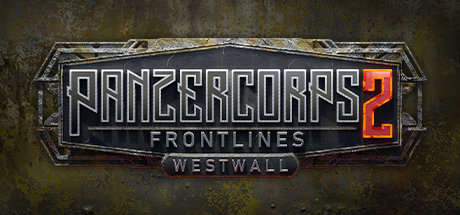
Objectives: Do's and a few Don'ts
Usually mission objectives are all about things you need to do to win.
This time there are a few exceptions from that rule: since the intro map is a recon mission, it is all about mobility. You don’t have to hold objective hexes – you just need to take them once to scout the location, and can abandon them afterwards.
Later, when you close in on Aachen, you also get told what you have to avoid, and this time it’s not a request. The reason for this is explained in the game of course.
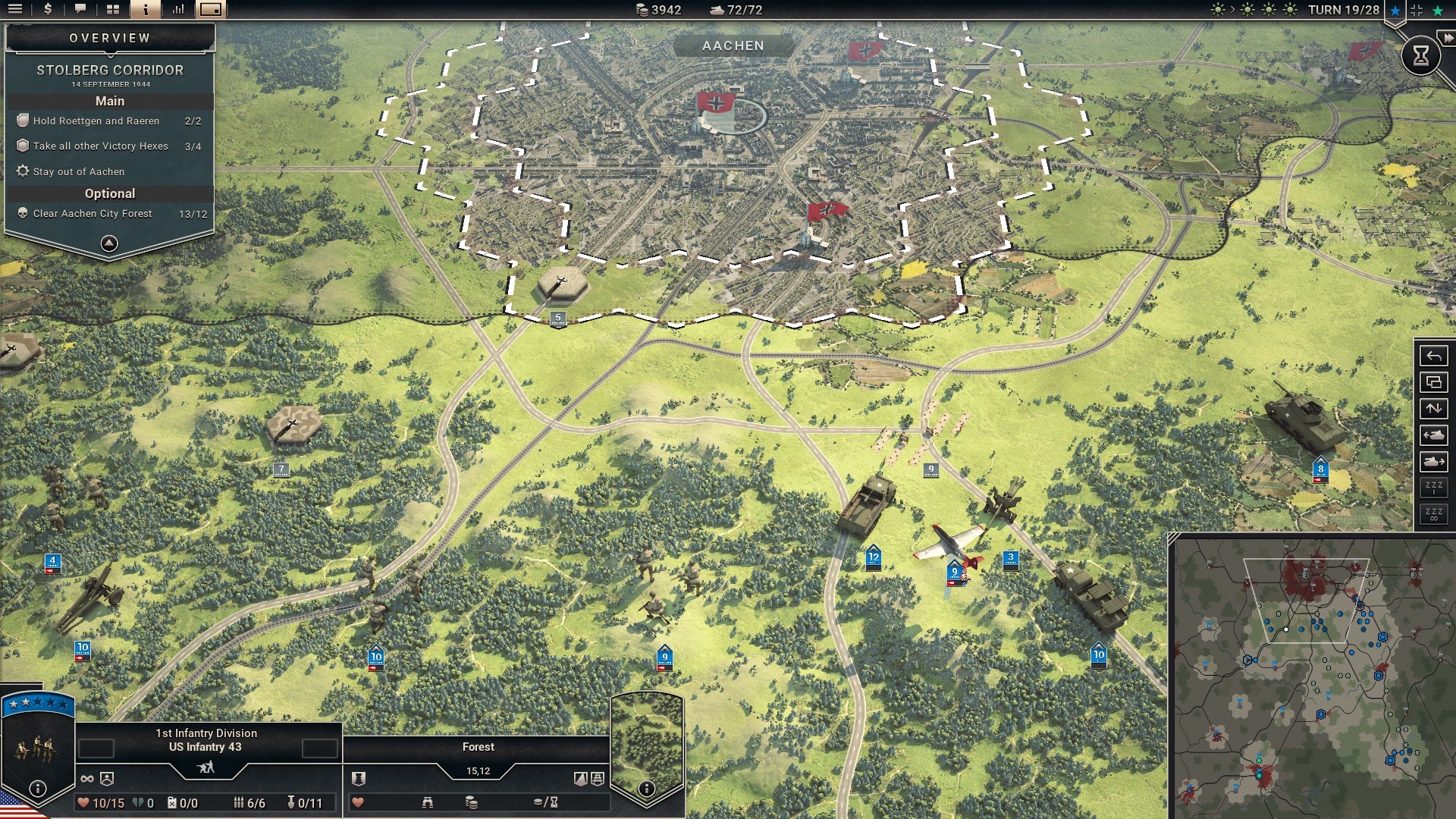
One map has an optional objective to capture German supply dumps, and the briefing explains how it can be achieved. The same method can be used to take most depots you encounter in this DLC. But in rare cases certain triggers might lead to unexpected results.
Other battles include objectives you have to complete earlier than the rest. Falling those may cost you a hefty bonus in the best case – in the worst you could lose your command when your superiors run out of patience.
These goals are not extremely difficult to achieve, but require you to stay focussed.
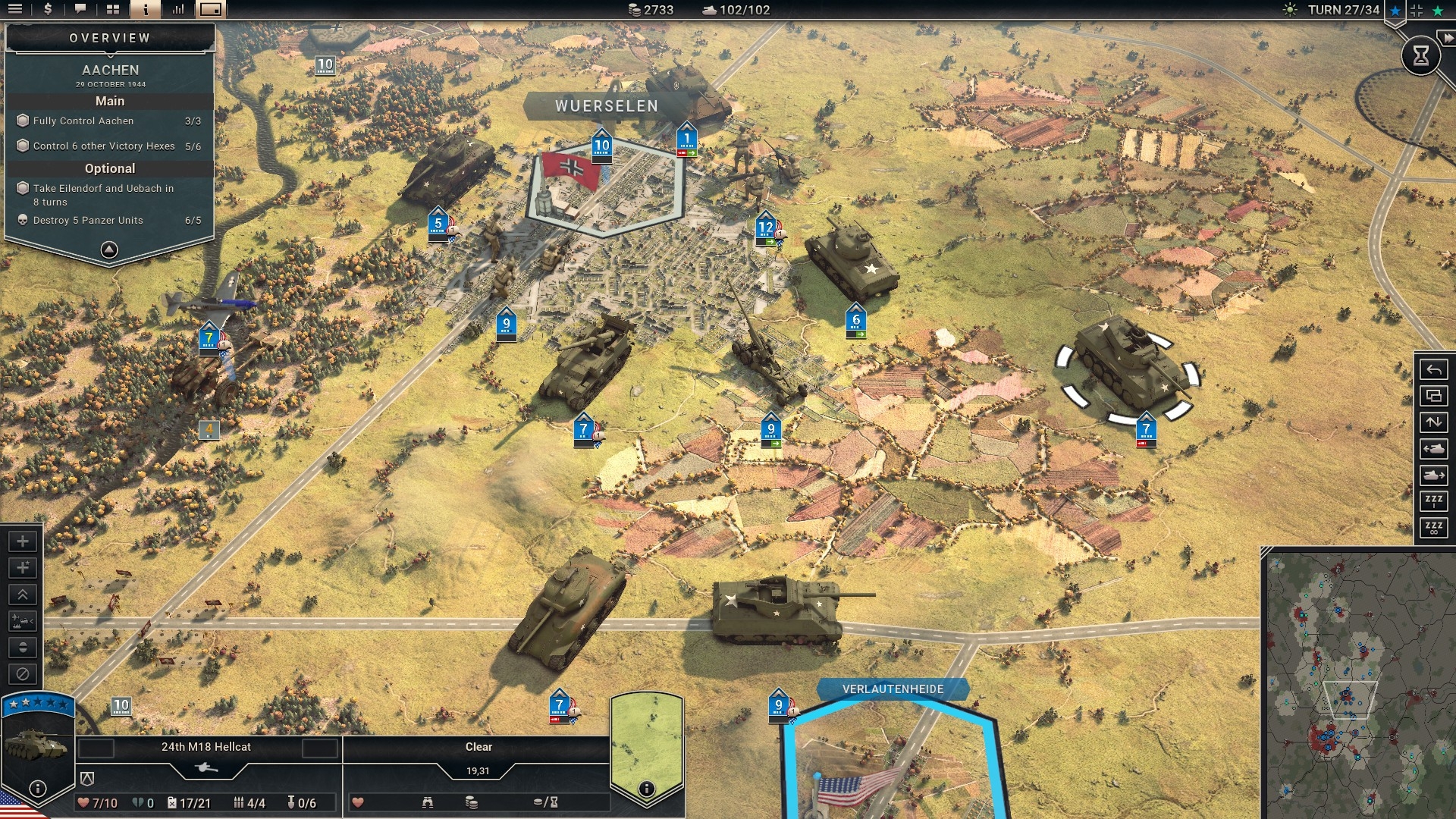
Prestige: Liberation vs. Occupation
Several maps play either on German-occupied territory, or in border regions. This has a direct impact on the way prestige can be earned by taking various locations.
Bigger rewards are always tied to objectives, or key locations like airfields and supply hexes. But non-objective towns and villages outside Germany.give a small one-time prestige bonus when you liberate them. Once you are across the border, inside Germany, no such reward is given.
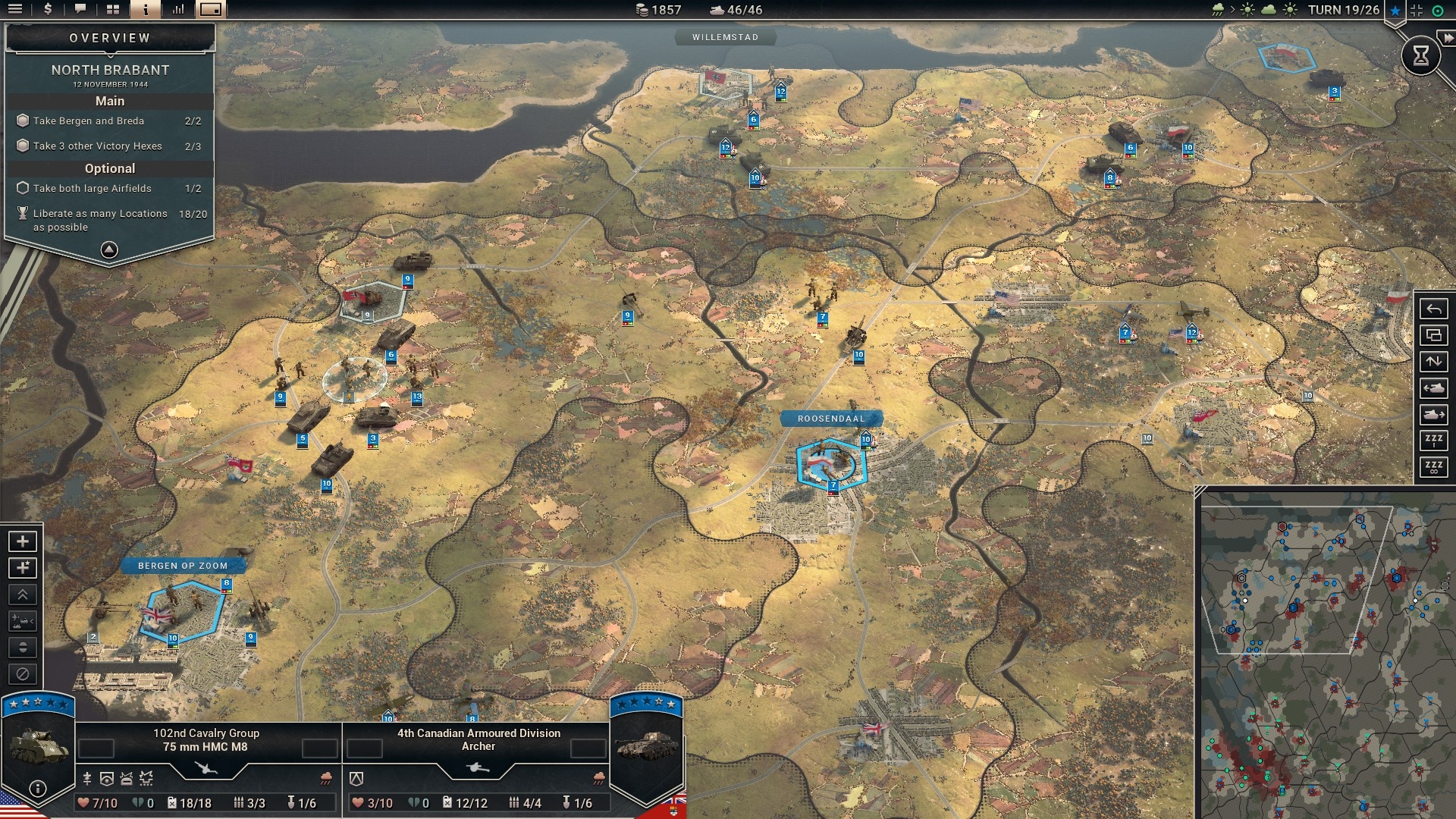
And not only that – when the Allies are battling to reopen the vital port Antwerp your progress in nearby North Brabant is directly affecting prestige and core slots at your disposal in the final stage of the campaign.
Events: Not written off
This DLC includes a variety of scripted triggers and events, both to add flavor and to impact gameplay.
We highlight the state of the German border defenses, especially during the intro mission, warn about significant enemy reactions in a few battles, inform about key developments elsewhere on the western front and more.

In a few battles you are presented with choices at the beginning. Some of them are easy decisions, for example when you get a chance to acquire cheaper veteran core units.
Other choices enable different approaches: do you call in Allied help when fighting in the Peel Marches, or do you get by with just a few core reinforcements instead? Later, do you opt to deploy a unique, hard-hitting, but low strength unit or do you prefer a few bonus core slots instead?
Visuals: The usual suspects
Frontlines - Westwall includes three new officer portraits to select from at the start of the campaign. Since it has become quasi-standard in recent DLCs each new battle gets introduced with a specific map before the actual briefing begins.

Those who played Bulge know the briefing character already. Internally we toyed with the name Deckard back then, but the basic idea of both Bulge and Westwall is that everyone knows each other at least since D-Day, or even longer. So he never gets explicitly introduced as it would feel odd that late.
You get to see him in various new environments now. We added a new post-battle state where he looks a tad battered, but also more relaxed with straps open, smoking a cigarette. This look is mostly used in debriefings, but may also pop up in selected events.
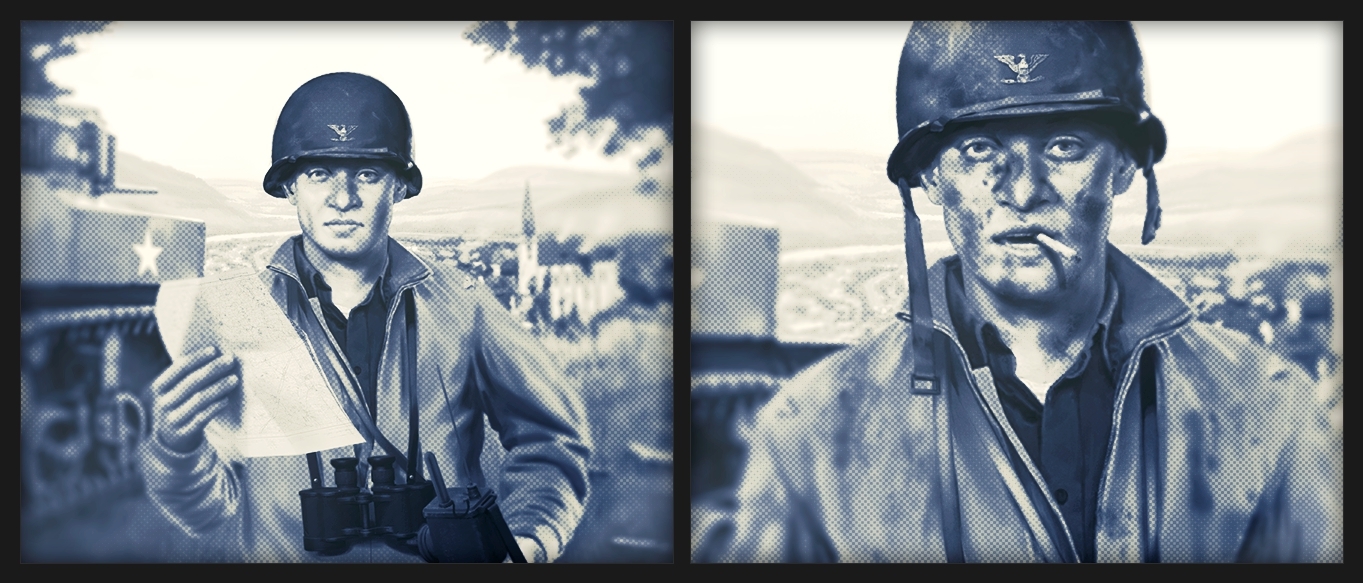
New Units I: On the Line
As the eponymous Westwall plays a central role in this DLC several additions were made to represent those German border fortifications in greater detail:
Various larger forts were built in selected locations along the Siegfried Line, but most often the Allies had to deal with smaller pillboxes, and sometimes with lots of them.

So we included a new pillbox unit. Unlike bigger bunkers they’re not overly strong on their own, but as part of a defensive network with mines, support units or even mobile reserves as backup they can keep you quite busy.
It’s worth noting that certain structures accept skins now, including those pillboxes, and modders can adjust their directions in the editor.
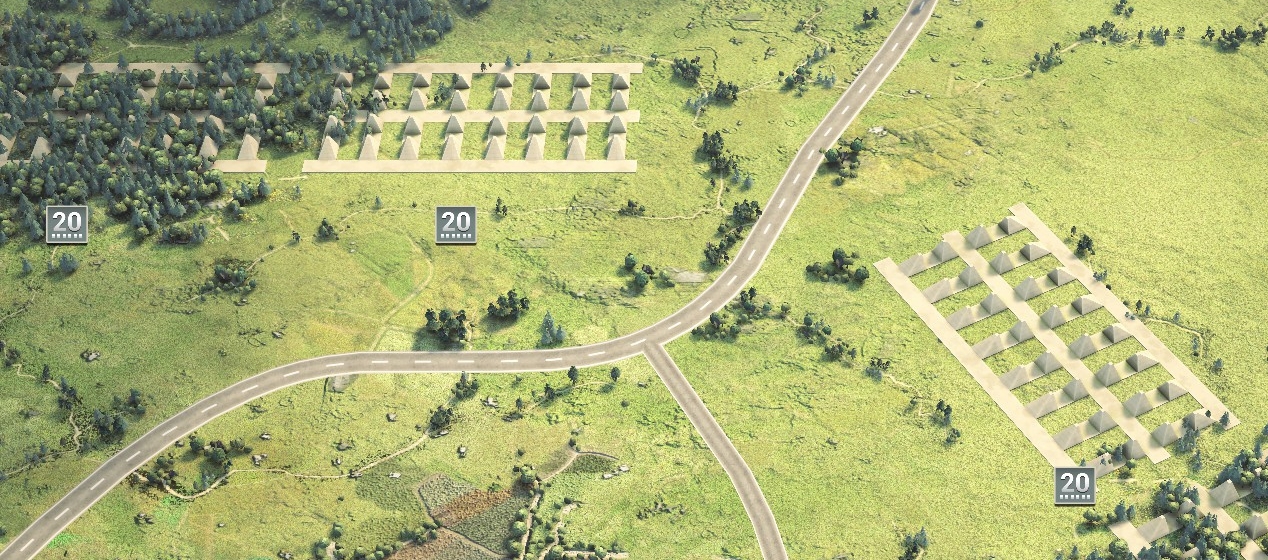
Key areas were also protected by so-called Dragon’s Teeth, a widely used form of anti-tank obstacle, which we included as well. These obstacles do not shoot back, but destroying them can be time-consuming.
It’s best to find gaps or other weak spots to plow on, although these do not always look as peaceful as in the pic above.
New Units II: Field Armor…
US tank crews often used everything they could get their hands on to increase protection, so many Shermans were soon covered with additional sandbags, track segments, wood or even selfmade side skirts.
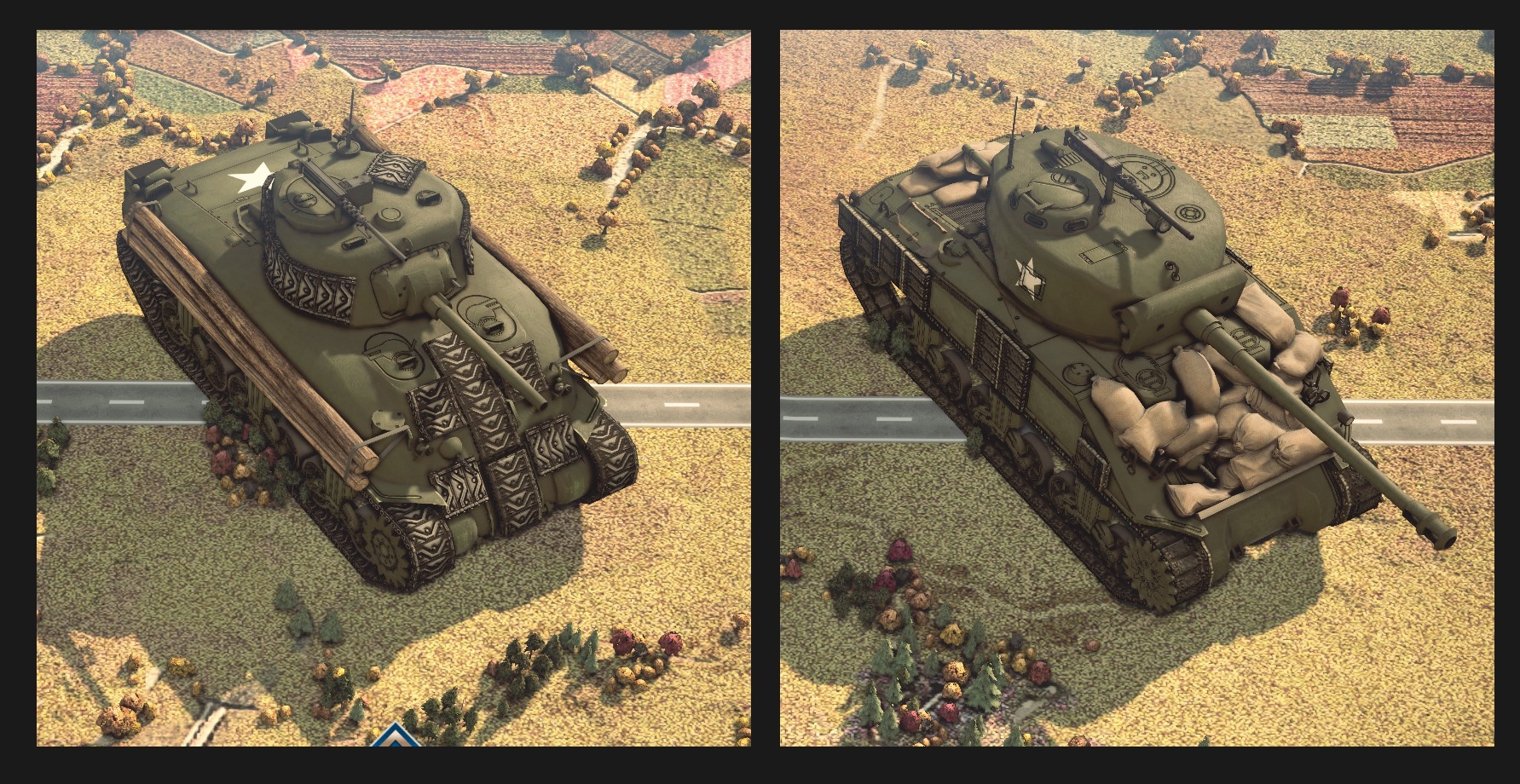
Such modifications, known as field armor, farmer armor, or even hillbilly armor became a common sight both in the Pacific Theater and in Europe.
While we cannot include every possible modification ever made, we added one modified variant for some of the main late-war versions. These modifications don’t turn regular Shermans into super units, but offer slightly better defense stats for a minor price hike.
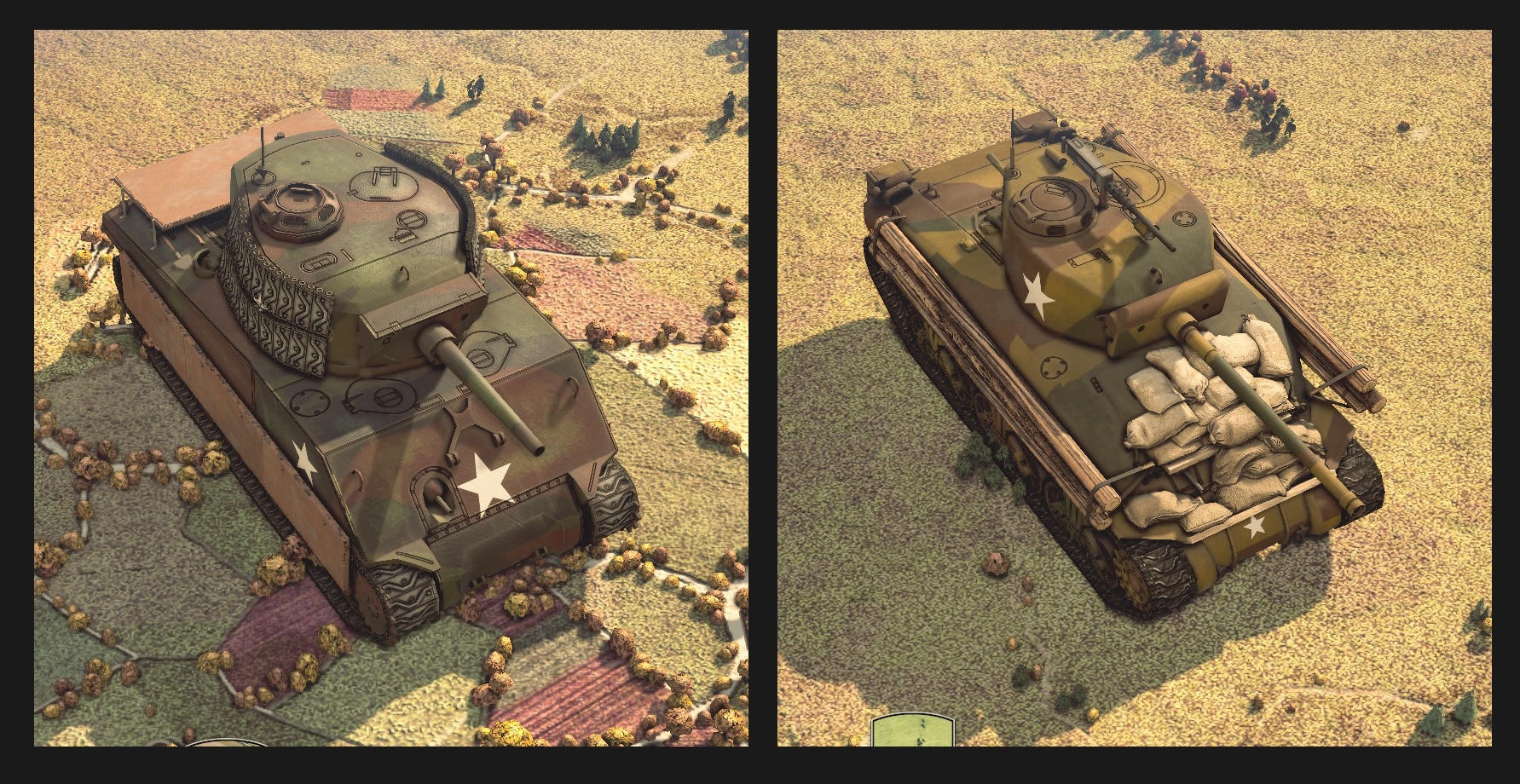
Field-armored tanks also have better unit-traits than their unmodified counterparts. This is a gameplay decision to make them more valuable, built on the idea that their crews excel in a certain area.
Modified Shermans count as limited equipment. A handful are added regularly as the campaign progresses, and objective rewards increase their overall number further.

Players can field and sustain a few units equipped with them, but may have to deploy vanilla tanks again if they take too many losses. This goes especially for the later, long-barrelled versions, while field-armor for the M4A1 and A3 tanks is available earlier, and in larger numbers.
New Units III: …and all the rest
Another unique addition to the US roster is the Dodge WC63. Derived from the similar, but lighter Dodge 4x4 series it represents a variety of enlarged Dodge 6x6 trucks.
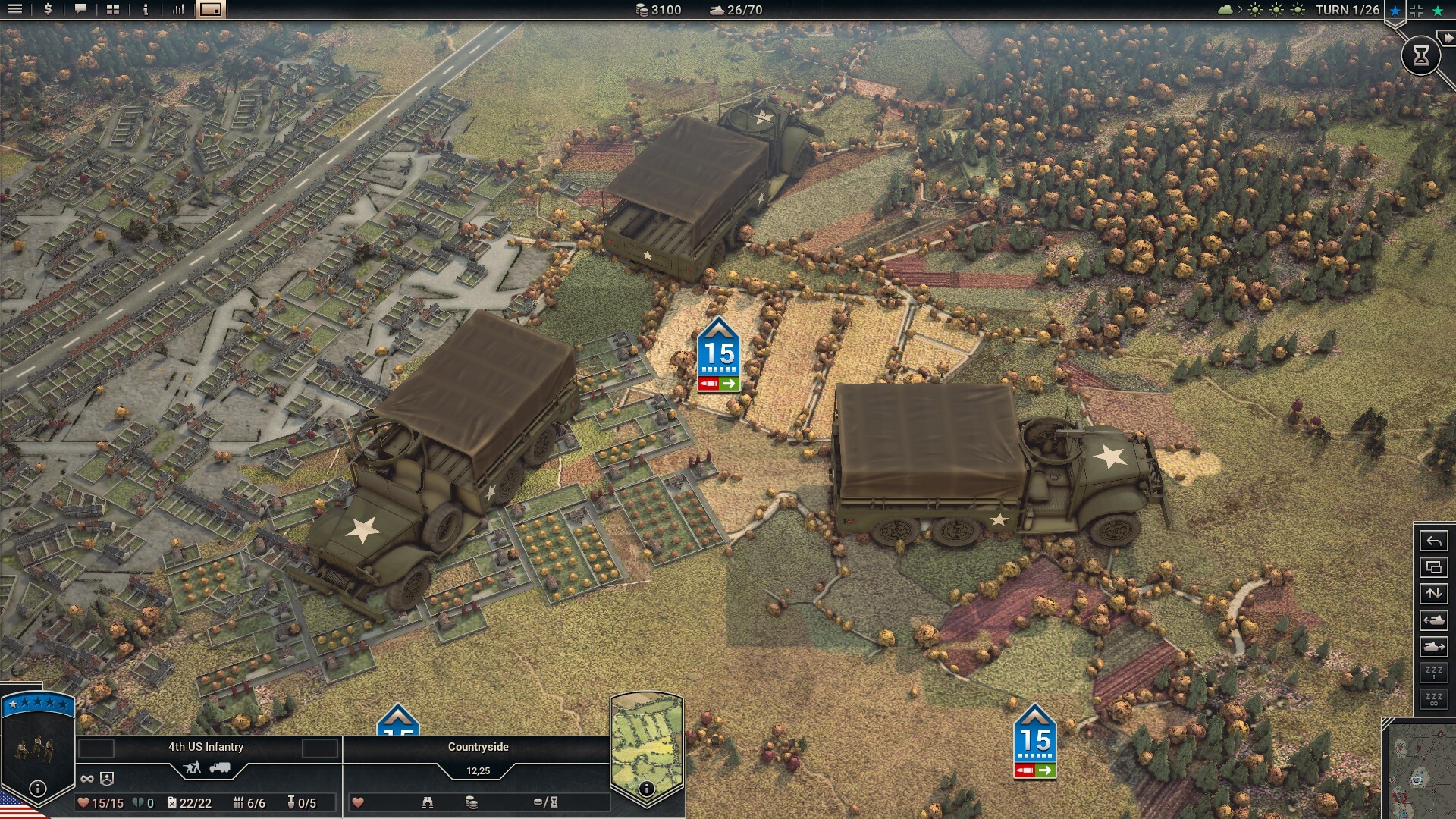
The new transport is cheaper than the Studebaker, has all terrain movement, and even an MG. But it can only carry vanilla infantry, paras and rangers, not engineers or heavy infantry, and it cannot tow all guns.
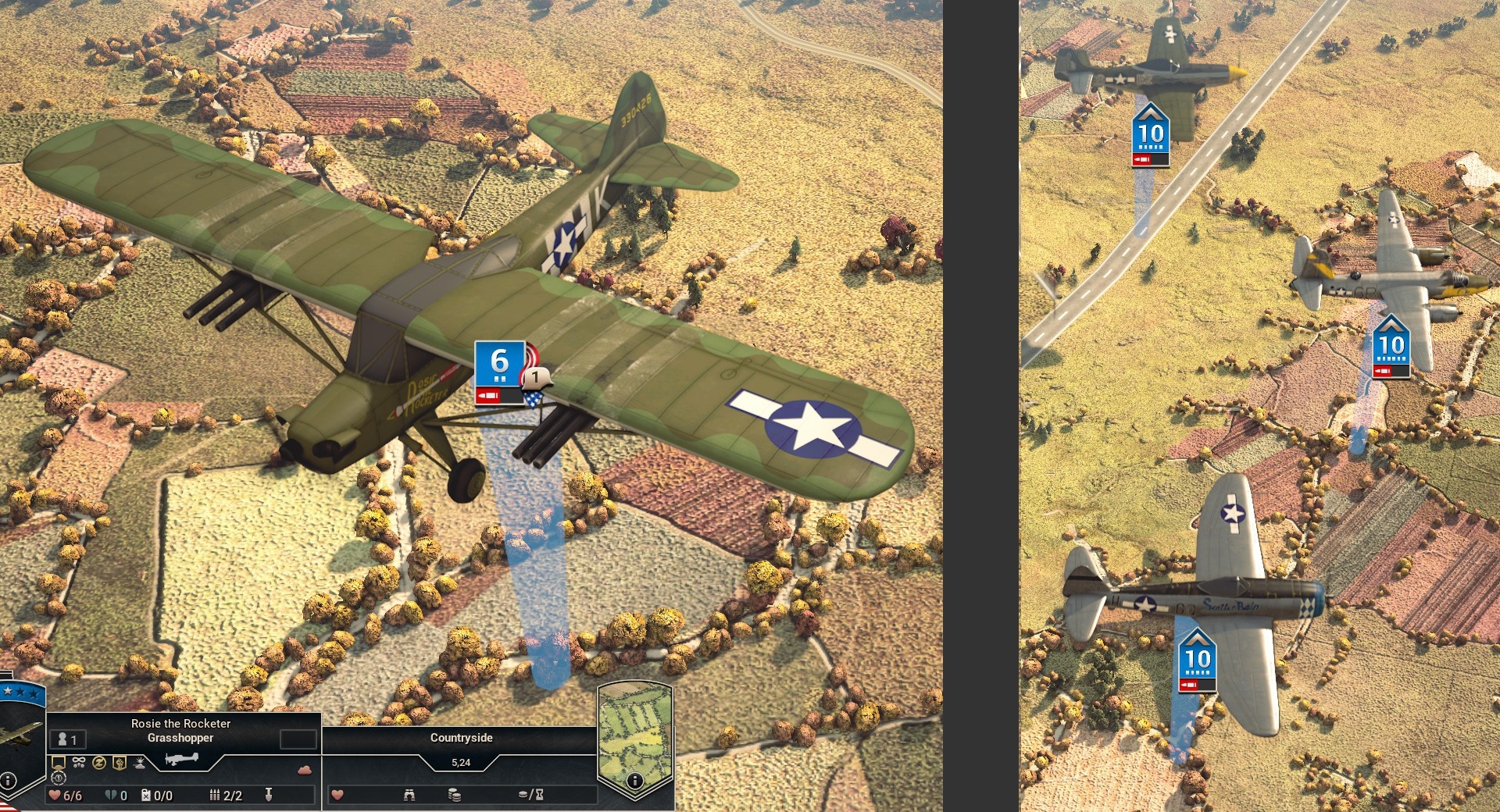
Last but not least a few more variants of known US warplanes are available now, with slightly improved stats. This includes a specific, armed version of the Grasshopper recon plane which appears as a specific aux unit first. Later in the campaign you receive a unique gift unit of this type.
On top of that shiny new skins made for specific USAAF aircraft have been added to the game, so the number of available, historic late-war skins has increased once again…
Conclusion
And so this third and last Dev Diary for this DLC comes to an end. Are you ready to punch through the Siegfried Line?
Panzer Corps 2: Frontlines - Westwall will be released on August 19th.

Objectives: Do's and a few Don'ts
Usually mission objectives are all about things you need to do to win.
This time there are a few exceptions from that rule: since the intro map is a recon mission, it is all about mobility. You don’t have to hold objective hexes – you just need to take them once to scout the location, and can abandon them afterwards.
Later, when you close in on Aachen, you also get told what you have to avoid, and this time it’s not a request. The reason for this is explained in the game of course.

One map has an optional objective to capture German supply dumps, and the briefing explains how it can be achieved. The same method can be used to take most depots you encounter in this DLC. But in rare cases certain triggers might lead to unexpected results.
Other battles include objectives you have to complete earlier than the rest. Falling those may cost you a hefty bonus in the best case – in the worst you could lose your command when your superiors run out of patience.
These goals are not extremely difficult to achieve, but require you to stay focussed.

Prestige: Liberation vs. Occupation
Several maps play either on German-occupied territory, or in border regions. This has a direct impact on the way prestige can be earned by taking various locations.
Bigger rewards are always tied to objectives, or key locations like airfields and supply hexes. But non-objective towns and villages outside Germany.give a small one-time prestige bonus when you liberate them. Once you are across the border, inside Germany, no such reward is given.

And not only that – when the Allies are battling to reopen the vital port Antwerp your progress in nearby North Brabant is directly affecting prestige and core slots at your disposal in the final stage of the campaign.
Events: Not written off
This DLC includes a variety of scripted triggers and events, both to add flavor and to impact gameplay.
We highlight the state of the German border defenses, especially during the intro mission, warn about significant enemy reactions in a few battles, inform about key developments elsewhere on the western front and more.

In a few battles you are presented with choices at the beginning. Some of them are easy decisions, for example when you get a chance to acquire cheaper veteran core units.
Other choices enable different approaches: do you call in Allied help when fighting in the Peel Marches, or do you get by with just a few core reinforcements instead? Later, do you opt to deploy a unique, hard-hitting, but low strength unit or do you prefer a few bonus core slots instead?
Visuals: The usual suspects
Frontlines - Westwall includes three new officer portraits to select from at the start of the campaign. Since it has become quasi-standard in recent DLCs each new battle gets introduced with a specific map before the actual briefing begins.

Those who played Bulge know the briefing character already. Internally we toyed with the name Deckard back then, but the basic idea of both Bulge and Westwall is that everyone knows each other at least since D-Day, or even longer. So he never gets explicitly introduced as it would feel odd that late.
You get to see him in various new environments now. We added a new post-battle state where he looks a tad battered, but also more relaxed with straps open, smoking a cigarette. This look is mostly used in debriefings, but may also pop up in selected events.

New Units I: On the Line
As the eponymous Westwall plays a central role in this DLC several additions were made to represent those German border fortifications in greater detail:
Various larger forts were built in selected locations along the Siegfried Line, but most often the Allies had to deal with smaller pillboxes, and sometimes with lots of them.

So we included a new pillbox unit. Unlike bigger bunkers they’re not overly strong on their own, but as part of a defensive network with mines, support units or even mobile reserves as backup they can keep you quite busy.
It’s worth noting that certain structures accept skins now, including those pillboxes, and modders can adjust their directions in the editor.

Key areas were also protected by so-called Dragon’s Teeth, a widely used form of anti-tank obstacle, which we included as well. These obstacles do not shoot back, but destroying them can be time-consuming.
It’s best to find gaps or other weak spots to plow on, although these do not always look as peaceful as in the pic above.
New Units II: Field Armor…
US tank crews often used everything they could get their hands on to increase protection, so many Shermans were soon covered with additional sandbags, track segments, wood or even selfmade side skirts.

Such modifications, known as field armor, farmer armor, or even hillbilly armor became a common sight both in the Pacific Theater and in Europe.
While we cannot include every possible modification ever made, we added one modified variant for some of the main late-war versions. These modifications don’t turn regular Shermans into super units, but offer slightly better defense stats for a minor price hike.

Field-armored tanks also have better unit-traits than their unmodified counterparts. This is a gameplay decision to make them more valuable, built on the idea that their crews excel in a certain area.
Modified Shermans count as limited equipment. A handful are added regularly as the campaign progresses, and objective rewards increase their overall number further.

Players can field and sustain a few units equipped with them, but may have to deploy vanilla tanks again if they take too many losses. This goes especially for the later, long-barrelled versions, while field-armor for the M4A1 and A3 tanks is available earlier, and in larger numbers.
New Units III: …and all the rest
Another unique addition to the US roster is the Dodge WC63. Derived from the similar, but lighter Dodge 4x4 series it represents a variety of enlarged Dodge 6x6 trucks.

The new transport is cheaper than the Studebaker, has all terrain movement, and even an MG. But it can only carry vanilla infantry, paras and rangers, not engineers or heavy infantry, and it cannot tow all guns.

Last but not least a few more variants of known US warplanes are available now, with slightly improved stats. This includes a specific, armed version of the Grasshopper recon plane which appears as a specific aux unit first. Later in the campaign you receive a unique gift unit of this type.
On top of that shiny new skins made for specific USAAF aircraft have been added to the game, so the number of available, historic late-war skins has increased once again…
Conclusion
And so this third and last Dev Diary for this DLC comes to an end. Are you ready to punch through the Siegfried Line?
Panzer Corps 2: Frontlines - Westwall will be released on August 19th.